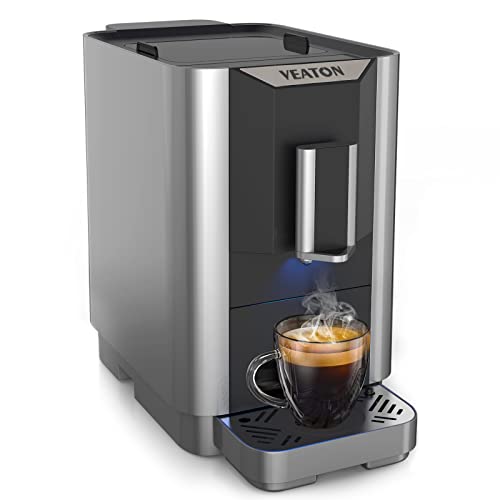Coffee and Espresso Machines
Espresso machines make use of pressure to push water through finely ground and tamped coffee beans. They produce a rich and flavorful brew.
Experts at the Good Housekeeping Institute recommend models that brew at a minimum pressure of 9 bars in order to get the most efficient extraction. Beware of companies that claim to offer more pressure than is necessary.
Types
The espresso machine, often called a coffee or espresso maker, produces the highest-quality, concentrated coffee that you like in your favourite cafe drinks using an average of 9 bars of pressure. These machines tend to have a variety of features like temperature and brew strength control as well as programmable brewing and multiple sizes of drinks. Some machines may have steam wands with either manual or automatic settings for creating texturized milk to create artwork with latte. There are three types of latte art of semi-automatic, super-automatic, and automatic. Each has its own level of control and automation.
Semi-automatic espresso machines are the most popular in specialty coffee shops. This allows baristas to have full control over the brewing process, but it is not as user-friendly as an automated or fully automated machine. To get the best espresso shot, grind the beans, then fill the portafilter, tamp it down, and adjust the extraction time.
Automated machines are equipped with an integrated grinder, and they measure and tamp the grounds for you. They automatically dispense enough water to extract espresso, and usually have the capacity to programate the size of the beverage. In our lab tests, they were the most favored type of espresso machine. They offer a good combination of control and consistency.
Functions
You'll need a reservoir to hold the water that you use for making coffee, whether you choose a steam-driven or pump-driven machine. You'll also have a heating element that heats up the cold water, generating the intense pressure needed to extract coffee from the grounds.
When the brew lever raises, it triggers the water inlet cam, which seals the pre-infusion valve so only hot water that has been pressurized to the maximum pressure can flow through the portafilter and into ground coffee. The water takes about 25 seconds to convert into espresso.
The hot-water tubing, also known as the insulated tube runs from the reservoir up to the spout on the top of your machine. The heating element of resistance heats the water as it passes through the warming plate of metal and the aluminum tube.
After the spout has been turned on, you'll place your cup underneath the spout, which will catch the espresso as it flows through the portafilter to your cup. The coffee maker also has a steam wand that can be used to heat and froth milk for drinks that are espresso-based, such as cappuccino and lattes.
Automated machines remove the guesswork from brewing. They are easy to use, programmable and are able to measure and grind beans and tamp down. In our Lab tests, they generally be the most effective because they are user-friendly and don't require an extensive amount of user expertise.
Materials

In an espresso machine, you'll find a veritable maze of copper tubes and boilers made of stainless steel. There's also a sophisticated firmware. They may appear complex, but at their core they perform one thing: push hot water through coffee that has been finely ground.
When buying an espresso maker be sure to take into account the size and space requirements as along with drink options, energy saving options, and brewing precision. Look for a steam button to activate the steam wand. This can be used to make the latte art and frothing the milk. The front of the machine has an indicator of pressure that will provide the operating pressure of the boiler and pump. Find the coffee maker with two needles, so that you can both the minimum and maximum pressure.
If you want to make more than just espresso, choose a machine that has various sizes of brew, such as the ristretto. There are models with a removable frothing hopper that allows for hassle-free, hands-free frothing. You can also switch between different kinds of milk easily. If you're suffering from hard water, choose one with a built-in softener to prevent mineral buildup and keep your espresso tasting fresh.
Certain manufacturers employ a thermostat that is digital, integral and proportional, to ensure an exact temperature range while making espresso. This feature ensures a consistent, high-quality cup of espresso every time. It also saves on energy costs, since the machine only operates only when it is needed.
Maintenance
The care and maintenance of espresso and coffee machines is becoming more important as they become accessible to home use. The best equipment can make all the world of distinction in your cup of coffee, but this is only true if your machine is operating properly.
A regular cleaning and maintenance routine should include everything from cleaning the steam wand and group head, to descaling, to changing the water filter frequently. If you're making between two and five cups of coffee each day, it is recommended to clean the main parts of your machine once a week. However, some components of the machine, like the water tank and grinder must be cleaned every two or three months.
It is also recommended to flush the machine each week. espressomachines involves locking the portafilter in position and running the brew process several times. This allows you to get rid of any coffee grounds or oils that are left behind. You can also use a brush or cleaner designed specifically for espresso machines to clean the portafilter.
Maintaining your coffee maker and espresso correctly will also make it last longer. It is essential to maintain the expensive espresso machine.
